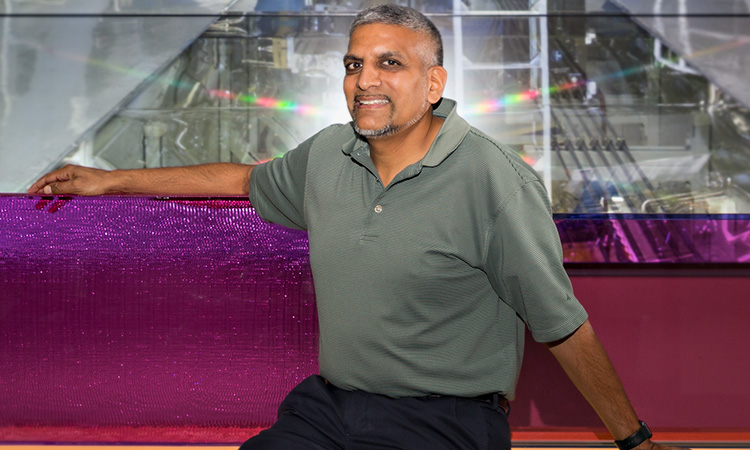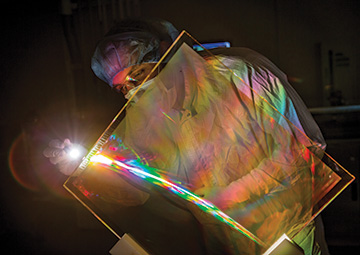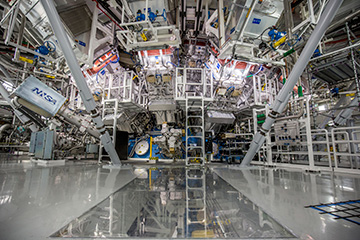
Tayyab Suratwala, in front of the NIF target chamber. [Image: Courtesy of LLNL]
As has been widely reported, the National Ignition Facility (NIF) of the Lawrence Livermore National Laboratory (LLNL), USA, has demonstrated, for the first time, fusion ignition—essentially, the production of more energy from fusion than the laser energy used to drive the reaction. The result, a landmark scientific and engineering achievement on many levels, was in no small part a triumph of optical technology. To learn more about the optical effort, OPN spoke with Tayyab Suratwala, the program director for Optics & Materials Science & Technology at NIF.
You’ve been at NIF for a quarter of a century. Tell us about how you first heard about the results from this landmark shot.
Tayyab Suratwala: Well, we know about these shots well in advance, of course—we take one of these types of shots every few months. This one took place on December 5th at 1:03 a.m. And there was anticipation about what the results of this one might be.
So Monday morning, I woke up, and the first thing I did was I texted the acting NIF director, and said, “Well, any results?” And he replied—within a millisecond, it seemed—and gave me a number that said we had achieved ignition. And I had my staff meeting right afterwards, and informed the team, and it was just high-fives everywhere. It was exciting.
“ Of course, as with any scientific experiment, you always say, ‘Okay; I’ve got to make sure it’s real.’ ”
—Tayyab Suratwala
Of course, as with any scientific experiment, you always say, “Okay; I’ve got to make sure it’s real.” So there was some caution. And then the second thing that ran through our mind—because we’re the optics group—we had to make sure our optics survived. We were shooting at the highest level, then, that had been done before. And those optics are being stressed to a point where new technologies are enabling what’s happening now. So at least with my team, the first reaction was, Are we going to be okay for the next shot?
Can you talk a bit about specific parts of the technology development at NIF that were important in driving this achievement—particularly from the point of view of the optics?
Making the optics has involved so many tremendous technological developments over the past several decades. It’s not just one thing. Also, to do something like this, it’s not just pure R&D. You have to do the pure R&D; you have to do a demonstration; you have to understand the fundamental science and technology behind it.
And then you got to do the hard part, which is tech transfer. I’m really proud of our group being able to take these technologies and turn it into something that is used in production, or used in a system in real life for specific needs.
With all that said, I can highlight a few particularly interesting technologies, dividing the list into two parts. One relates to the making of NIF, the other to the operations of NIF.
The target chamber of LLNL’s National Ignition Facility (NIF). On 5 December 2022, 192 laser beams delivered 2.05 megajoules (MJ) of energy to a tiny fuel pellet to create the first fusion reaction that produced more energy than it consumed. [Image: LLNL] [Enlarge image]
In the making of NIF, two big optical-component technologies kind of stick out. The first was the neodymium-doped phosphate laser glass. That was a new material developed in the late 1980s in terms of composition, and then turned into a technology of fabricating at large scales. There were so many technical challenges that were overcome—in terms of reducing the OH content in the glass so that you don’t reduce the gain of the laser; protecting the glass from tiny little platinum inclusions; getting to the right level of optical homogeneity, which is required for optics.
This was the first time that an optical-quality glass was made in meter class by a continuous melting process. A lot of offshoot technologies came from that. The vendors we work with that made this possible, ended up using a lot of those capabilities to make other types of optical glass. We made five miles of this optical-quality glass. And it is the heart of the laser; it is the amplifier.
The second example from NIF’s development was forming large nonlinear optical crystals—potassium dihydrogen phosphate (KDP) crystals. They had to be grown in crystal sizes that represented the world’s largest single crystals ever made. The technology to grow those without cracking them, growing only a single crystal, making them with parts-per-trillion purity levels, understanding the kinetics of crystal growth, and knowing the defects—it was just amazing.
How about on the operations side of NIF? What was most important there on the optical side?
This is where the question gets into: How did we get to these very large, high energy and power levels in this laser that exists nowhere else in the world? And here, the name of the game is optical damage.
We’re shining so much fluence through these materials that defects in the materials can absorb laser light and cause damage. And the “fuse” on NIF, if you will, has been largely the fused-silica final optics. They’re basically two major components—a focusing lens and an optical grating—that are the end of NIF, right before the target chamber.
When we first were designing and starting to build NIF, the quality level in the optics were such that if you were to take the kind of shot we do today, you would have gotten more than 50,000 damage sites on the optic. Basically, after just a few shots, you would have destroyed that optic; you’d have to throw it away. So there had to be a tremendous development of the quality of the optic. Now, the bulk fused-silica glass is very high quality. The problem is defects at the surface. It depends on how you process the optic, how you grind it, how you polish it, how you clean it, how you store it—all of those become factors with respect to nanometer-level impurities left behind on the surface.
How did you overcome problems like that?
“ We had to figure out how to actually expand the art of optical fabrication—to take it to the next level. ”
—Tayyab Suratwala
Success on that had kind of a threefold action. Number one, we had to figure out how to actually expand the art of optical fabrication—to take it to the next level. We had to understand what polishing compounds do, what grinding particles do to the surface, from a tribology, mechanics, chemical perspective, at a level that hadn’t been done before. And that had a lot of spinoff technologies in industry as well.
Step number two was, we came up with a patented technology that only exists at Livermore. It’s a chemical process, called AMP, that removes nanometer-level absorbing precursors and that leads to a further increase in damage resistance. And with those efforts and with further versions of this chemistry process, we have now got things to the level that, at the level of the shots currently being done at NIF, the optic would basically not be damaged.
But there’s a third chapter to all of this. We made these essentially almost-perfect optics to install in NIF. But then when we started using NIF, and turning up the knob, we had debris coming from the targets, from other optics, from stray light shining in various places. So in the last five years, it’s been a game of finding out where the debris is coming from in the system and coming up with mitigations for that.

Marcus Monticelli at the LLNL National Ignition Facility (NIF) inspects the antireflective coating on a NIF grating debris shield. [Image: LLNL/J. Laurea]
The most recent mitigation—the one that led to our being able to take these last two shots, including the 2.05-megajoule shot that got us to ignition—was designing, fabricating and implementing a special debris-blocking optic that we inserted into the system to protect the other critical, very expensive optics from damage. And that allowed us to get to the level we needed.
What about things that have happened outside of NIF—have other labs and partners contributed to developments?
Absolutely. We’ve been in a very collaborative environment, with multiple R&D contracts with universities and even more so with industry. You know, NIF has over 8,000 large optics and 40,000 small optics (six inches or smaller). That’s a lot of optics. In fact, we had to increase the US production capacity by almost ten times to achieve the build of NIF.
So industry had to be a key part of this. A high level of collaboration was absolutely essential. What we do is, we have an R&D program and actually a mini production site at Livermore, where we develop new processes. And as we make improvements, we give that information back to the industry and say, “Hey, if you use this, you can make a better product, or get better yield, or lower the costs, or improve the quality.”
So that collaboration, both with academia and in industry, has been paramount to the success on the optics on NIF.
What role do optics and photonics play, beyond just the laser system, in enabling inertial confinement fusion?
There’s a lot. It’s actually pretty amazing, thinking about what’s “under the hood.”
Obviously, everyone talks about NIF as this laser. But to make the optics part of NIF work, the supply chain and the metrology and the prep of the optics involves a lot of other optical components. We actually have a number of side-lab lasers for laser damage testing; we have many different labs to do that. We have a facility that even uses a laser to repair the damage site, when we recycle the optics that come off of NIF. And we have a laser system used to “condition” the optics, to pre-treat them with laser light so they survive when they’re exposed to high fluence.
We make large optical gratings, and we use imaging systems and laser systems to do that. We even have a big facility just to measure the performance of that grating. And then we also have lots of optical metrology. Some of them are commercial instruments, but a lot are custom-made tools that we use on site to find the various flaws and defects, so we can catch them before we install them in the system.
So, yeah—there’s lots of offshoot optics that support NIF.
You’ve had this successful demonstration of ignition—what sort of things are you looking at now, from the point of view of the optics, to move NIF forward?
When we run NIF, the optics is one of the things that limits the number of NIF shots or the amount of power and energy that can be used. For example, if you were to take a shot and just completely destroy the optic, that would be an obvious limit. Of course, it’s my job to make sure that never happens, because the time constant to replace those optics is quite long—a year and a half or so.
But in a sense we have a facility that intentionally allows some damage to occur on the optics. It’s like driving a car in the red line—we don’t want to break the engine, but we want to stay in the red line to test the limits, and frequently change the tires and change the oil.
So we have optics that come off in this, and we recycle them and repair them at a fraction of the cost and in a fraction of the time it took to make the initial optic. That rate is our limiter. And to go take NIF to a higher level, we have to make sure that the rate at which we recycle the optic stays within a capacity range that we can still continue to run NIF.
How do you do that?
We have a number of technologies being developed. That includes things like mitigation of the debris-induced damage that I talked about before. It also means controlling other mechanisms of laser damage that occur as we turn up the knob on the laser energy. Every time we turn up a knob, a new mechanism of laser damage ends up coming its way.
“ NIF has not reached its full potential—there’s a lot more we can do with it. It’s really, really exciting. ”
—Tayyab Suratwala
So today we are at 2.05 megajoules. We are gearing up, with mitigations, to get us to 2.2 megajoules, hopefully later in the next calendar year, and are on a good trajectory to get there. And there are also plans to get us to 2.6 megajoules or even 3.0 megajoules. So NIF has not reached its full potential—there’s a lot more we can do with it. It’s really, really exciting.
From the point of view of the optics we’ve identified the key things we need to do to get there. One is this debris challenge that we’ve partially solved, but we will have more to do there. Another is a mechanism where, if you shoot at very high fluence, there is a self-degradation of the optic surface itself. Even though the optic surface is near perfect, when you shoot it with the laser, essentially something is coming off the surface of redepositing back on and causing a degradation in that. We are starting to understand this phenomenon; we just need to come up with mitigations for it, and that will be a new challenge.
And yet another one is that as you get to higher and higher fluence, you need to develop a new type of optic block the light that’s going backward. We call that a high-fluence optical filter—our trade name for it is called a Blue Blocker; that’s a new optic type that’s being developed as we speak.
Another technology that needs to be developed is, as we run this loop, we have to be able to “load level.” We need to recycle the optics, but we can’t take all of the optics out in one week; we have to pull out only a certain number of them.
How do you do that kind of load-leveling?
To do it, we can actually put little shadows in the beamline that allow us to load-level, and decide when to take those optics out. We call it a programmable spatial shaper. It’s a liquid-crystal device that allows you to put gray regions and black regions into the beam line, to prevent individual, tiny damage sites from becoming bigger, and control when we need to remove the optic from the beamline.
And finally, there are lots of opportunities for increased efficiency in how we recycle the optics. So when an optic comes out, it has all these small damage sites on it. We have to determine which are the sites we need to repair, down to a very small size. There are opportunities to improve the efficiency of that using machine learning and AI.
You are obviously heavily involved with the nuts and bolts of making the optics work. I’m interested, though, in getting your perspective on what the work at NIF means for inertial confinement fusion as an approach to fusion energy, and whether and how it might be scaled up.
One thing to remember is that NIF was designed as an R&D facility. It doesn’t have a good wallplug efficiency; it’s designed to understand the science, and ignition is really the goal here.
I think of it like getting to base camps. We’re walking up the mountain, and we’re getting to various base camps. We just reached a really important base camp of getting to ignition.
Getting to fusion energy for a power plant is going to be another big grand challenge, just like NIF was. I think the team is excited to participate in that; Livermore can make a contribution to that we. Obviously, there’s money going in from the government, which is great; industry’s getting involved partnering with them. I’m hoping the kind of timeframes people are talking about—a number of decades—will turn out to be true.
It is a grand challenge; it will take effort to get there. But I’m hoping at least that my kids might be able to get energy from a fusion power plant.
That’s a great motivator, certainly.
“ This work at NIF is just a huge example of teams working together to kind of make the impossible happen. ”
—Tayyab Suratwala
Yes. And you know, this grand challenge—this work at NIF is just a huge example of teams working together to kind of make the impossible happen.
For me, being here for 25 years and seeing everything that’s under the hood, it’s just mind boggling to see where we are. Not just in the optics area, but in all the other areas—diagnostics; targets, rad control, software, all of it. When I think about the problems that we have had to overcome in making this a success, and multiply that by all the other groups, it’s just absolutely amazing.
I’ve spent half my life on this project. I’ve seen it grow from dirt into the facility we have and now to ignition. And I’m really excited about the future as well.


